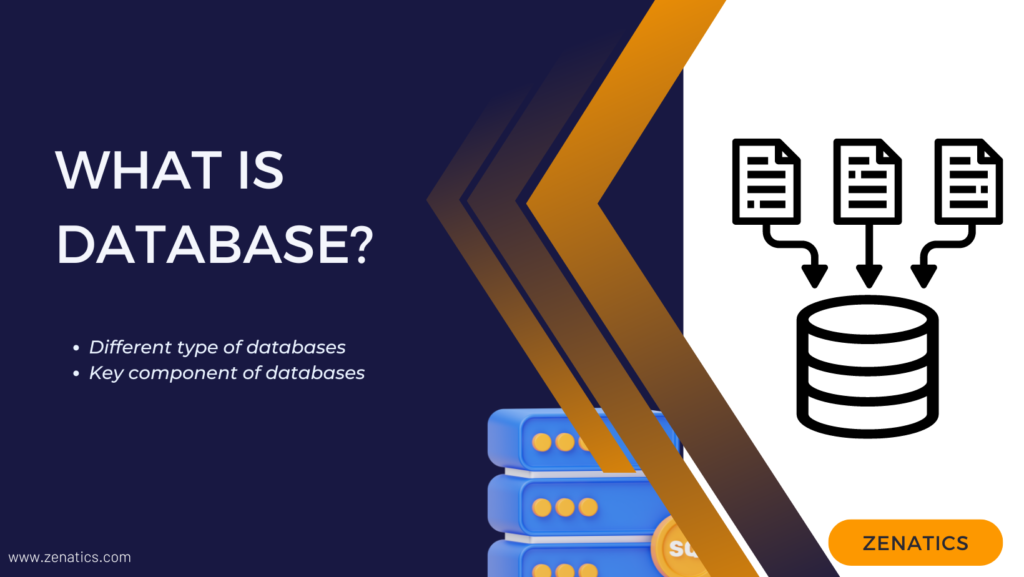The word “database” and the question “what is database” are used often in today’s data-driven society, but what does it actually mean? A database is, in short, a systematic set of structured data that is usually kept electronically within a computer system. Databases are essential for a wide range of applications, including dynamic website development, company operations management, and scientific research assistance. We’ll examine the sorts of databases, their principles, and their importance in contemporary computing in this piece.

What is Database?
Database is a structured collection of data or an organized set of data that makes it possible to store, retrieve, and manipulate it with efficiency is called a database. Imagine it like an electronic filing cabinet, where data is organized and arranged for convenient access and administration. Tables comprise rows and columns that represent distinct entities and their attributes; they make up databases.
Databases offer a centralized location for data storage, making it simple for users to access, modify, and analyze the data. Databases are the foundation of data-driven applications, whether you’re using them to track consumer transactions, manage inventories, or analyze scientific datasets.
The world is changing with the evolution of AI, and focus has shifted towards AI and data science. So with the sudden boom in data science and AI, learning and manipulating data has become a critical part.
Key Components of Databases
The key component of databases are data, tables, schema, queries and indexes:
Data – The data itself is the central component of every database. This data is the information that needs to be managed and kept. It can be text, numbers, photos, or even multimedia files. The term “data” describes unprocessed facts, numbers, statistics, or information that is gathered, saved, and examined for a variety of reasons. It can consist of any kind of digital content, such as text, numbers, pictures, audio, and video. Data is fundamentally the building block of knowledge and information, acting as the basis for analysis, communication, and decision-making in almost every sector and subject.
Tables – Data is arranged in databases using tables, which have rows and columns. A single record or entity is represented by each row, and a certain attribute or field of that record is represented by each column. A table in an online store’s database, for instance, might have rows for each product and columns for details like the product’s name, price, and quantity in stock.
Schema – The table, column, and relationship relationships within the database are all defined by the schema. It acts as a guide for how information is arranged and kept in the database.
Queries – A set of instructions defined in a query language such as SQL (Structured Query Language) is what users issue to access or alter data contained in a database. Users can pick particular records, filter data according to predetermined criteria, and update records that already exist using queries.
Indexes – Indexes are data structures that enable fast access to particular rows in a table, therefore enhancing the pace at which data is retrieved. They let consumers find information fast without having to browse the whole dataset, much like an index in a book.
Different types of Databases
There are several kinds of databases, each with specific uses and specifications in mind. Some of the most typical kinds are listed below:
Relational Databases (RDBMS) – Relational databases (also known as RDBMSs) arrange data into tables with pre-established connections or relations between them. They manage and query data using Structured Query Language (SQL). Relational database management systems (RDBMS) include Microsoft SQL Server, MySQL, PostgreSQL, and Oracle Database. Relational databases are extensively utilized in corporate applications and are excellent at managing structured data.
NoSQL Databases – No SQL provide greater flexibility when managing unstructured or semi-structured data. They work well in situations where distributed architectures, rapid development, and great scalability are necessary. NoSQL databases cover a wide range of models, such as columnar (like Apache Cassandra), document-oriented (like MongoDB), key-value stores (like Redis), and graph databases (like Neo4j).
Time-Series Databases – These databases are designed to store and analyse time-indexed data points. Applications handling time-stamped data streams, such financial trading platforms, Internet of Things devices, and monitoring systems, are a good fit for them. Time-series databases facilitate effective data aggregation, analysis, and visualization by optimizing time-series data retrieval and storage.
Graph databases – Graph databases are specialized for describing and accessing interconnected data. They are perfect for applications like social networks, recommendation engines, and network research because of their ability to traverse relationships between items effectively. Graph databases allow for complicated searches to find patterns and insights by storing data in nodes, which represent entities, and edges, which represent relationships.
Spatial Databases – Spatial databases are dedicated to the retrieval of geographical data, including geometry, maps, and geographic information system (GIS) data. In order to facilitate location-based applications, urban planning, and geographical analysis, they enable spatial data types and processes for representing and manipulating spatial objects.
Conclusion – In this post we have explained what is database? and what are the different types of databases and key components of databases.